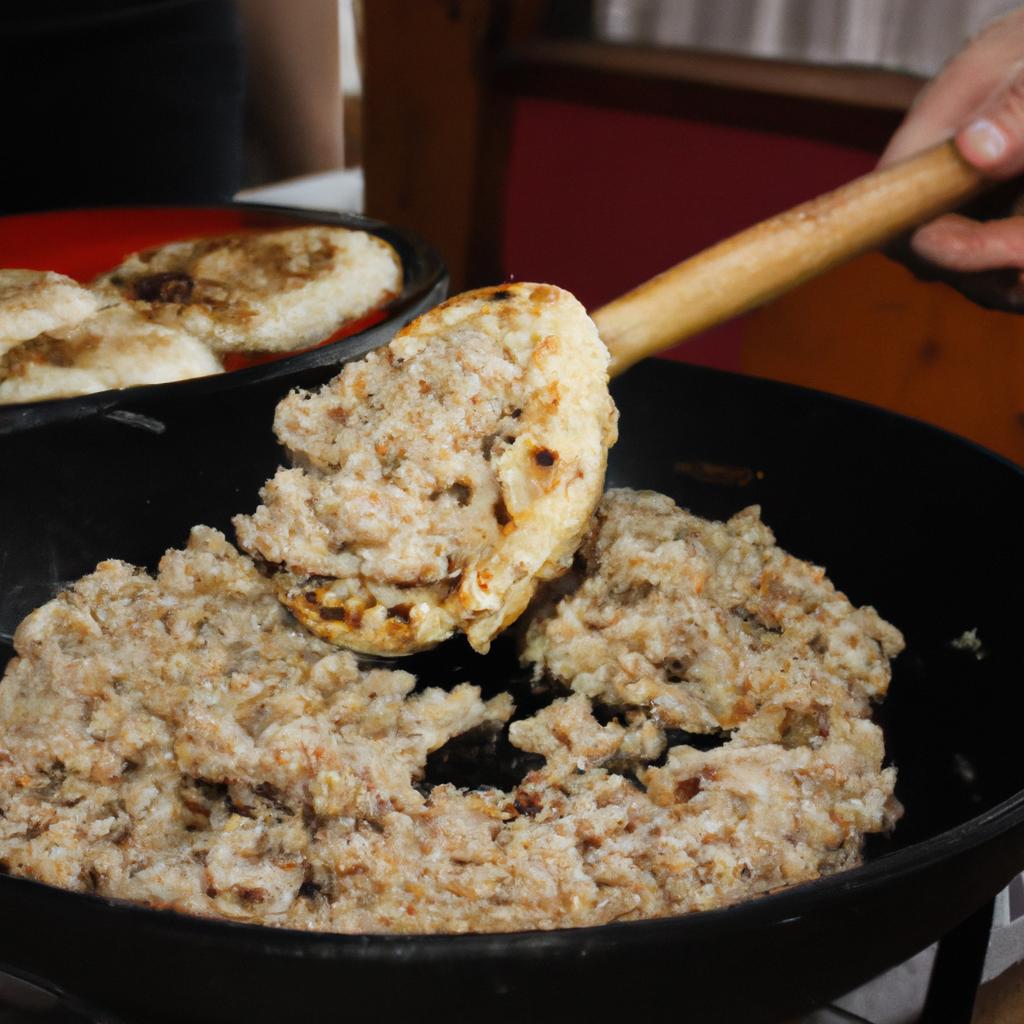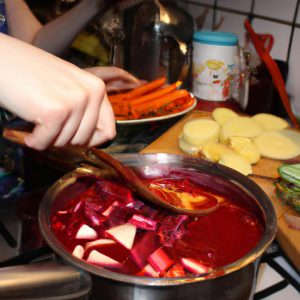Kugel: Ashkenazi Heritage and Food

Kugel, a traditional dish originating from Ashkenazi Jewish cuisine, holds immense significance in preserving and celebrating the cultural heritage of this community. This article delves into the multifaceted dimensions of kugel as an embodiment of Ashkenazi identity and explores its historical roots, culinary variations, and symbolic meanings. To illustrate its importance within the context of Ashkenazi culture, let us consider a hypothetical case study: Rachel, a young woman born into a family with deep Ashkenazi roots, finds herself drawn to her heritage after stumbling upon her grandmother’s hand-written recipe for potato kugel. Intrigued by this tangible link to her ancestry, she embarks on a journey to uncover the essence of kugel and its role in preserving their shared history.
The exploration of kugel as an emblematic representation of Ashkenazi food culture requires an examination of its historical origins. With documented references dating back several centuries, it is evident that kugel has endured through generations as a staple comfort food among Eastern European Jews. Its humble beginnings can be traced to simple peasant fare; however, over time, kugel adapted and transformed to reflect the evolving tastes and resources available in different regions. From sweet noodle-based versions to savory potato-based renditions, kugel has become a versatile dish that showcases the creativity and adaptability of Ashkenazi cooks.
In Rachel’s case, her grandmother’s hand-written recipe for potato kugel serves as a tangible link to their shared history. As she delves into the origins of this dish, she discovers that potatoes were not always a common ingredient in traditional kugel recipes. Potatoes only became widely available in Eastern Europe during the 18th century, leading to their incorporation into various dishes including kugel. This adaptation reflects the resourcefulness of Ashkenazi Jews who embraced new ingredients and incorporated them into their culinary traditions.
Beyond its historical roots, kugel also holds symbolic meanings within Ashkenazi culture. Its presence on holiday tables and festive occasions signifies continuity and connection to the past. The act of preparing and consuming kugel becomes an expression of love and respect for tradition, fostering a sense of belonging and pride in one’s heritage.
As Rachel continues her journey, she encounters different variations of kugel that reflect regional differences among Ashkenazi communities. For example, she discovers that in some regions, apples are added to sweet noodle-based kugels, symbolizing abundance and harvest. In other regions, carrots or zucchini may be used instead of potatoes, showcasing the adaptability of kugel to local produce availability.
Through her exploration of kugel, Rachel comes to understand that this seemingly simple dish represents much more than just food. It embodies resilience, resourcefulness, and cultural identity. By preserving and celebrating the tradition of making kugel, Rachel recognizes her role in passing down her family’s history to future generations.
In conclusion, the significance of kugel within Ashkenazi Jewish cuisine cannot be underestimated. It serves as a tangible link to ancestral roots while also representing adaptability and resilience throughout history. Through her journey with her grandmother’s recipe, Rachel discovers the multifaceted dimensions of kugel and its role in preserving and celebrating Ashkenazi culture.
Origins of Kugel
Kugel, a traditional Ashkenazi dish, has an intriguing history that traces back to the Jewish communities of Eastern Europe. To understand its origins and significance within Ashkenazi heritage, it is essential to examine the cultural context in which kugel emerged.
One illustrative example of how kugel reflects Ashkenazi culture can be seen in its adaptation over time. As Jews migrated across different regions, they encountered new ingredients and culinary traditions, influencing the evolution of kugel recipes. For instance, in Poland, where potatoes were abundant and readily available, potato kugel became popular. Similarly, in Lithuania and Russia, noodle-based variations gained popularity due to the accessibility of wheat flour.
The historical development of kugel reveals several key aspects that are deeply intertwined with Ashkenazi identity:
- Nostalgia: Kugel serves as a nostalgic reminder of generations past for many individuals who grew up with this dish as part of their family’s culinary repertoire.
- Community: The process of making kugel often involves collaboration among family members or neighbors during festive occasions such as Shabbat dinners or holidays like Passover.
- Continuity: By passing down cherished recipes from one generation to another, families maintain a sense of continuity and connection to their ancestral roots.
- Adaptation: The versatility of kugel allows for adaptations based on regional preferences or ingredient availability while still preserving its essence as a beloved traditional dish.
To further illustrate the diverse manifestations of kugel throughout history, consider the following table showcasing four distinct types commonly found within Ashkenazi cuisine:
| Type | Main Ingredients | Texture | Flavor Profile |
|---|---|---|---|
| Potato | Potatoes | Crispy | Savory |
| Lokshen | Egg noodles | Creamy | Sweet and Cinnamon |
| Apple | Apples | Moist | Sweet and Spiced |
| Vegetable | Carrots, Zucchini | Soft | Savory and Fragrant |
As kugel has evolved over generations, it continues to be a symbol of cultural heritage and an essential component of Ashkenazi cuisine. In the subsequent section on “Traditional Ingredients,” we will delve into the key components that lend their distinct flavors and textures to this beloved dish.
Traditional Ingredients
From its humble beginnings, the dish known as kugel has evolved into a beloved staple of Ashkenazi cuisine. In this section, we will delve further into the traditional ingredients that contribute to the unique flavor and texture of kugel.
One example of how kugel has been passed down through generations can be observed in the Cohen family. For over a century, their recipe for potato kugel has remained unchanged, with each generation meticulously following the same steps. This commitment to tradition is reflective of the broader cultural significance placed on preserving culinary heritage within Ashkenazi families.
To understand the essence of kugel, it is essential to examine its key ingredients:
- Noodles: The foundation of many kugel variations, noodles provide substance and structure to the dish.
- Eggs: Acting as both a binder and a source of richness, eggs play a crucial role in achieving the desired custard-like consistency.
- Sugar: As an inherent component of Ashkenazi cooking, sugar adds sweetness and balances out other flavors present in savory versions of kugel.
- Cottage cheese or sour cream: These dairy products lend moisture and tanginess to enhance the overall taste profile.
The emotional connection between individuals and their favorite types of kugel goes beyond mere sustenance. It evokes memories of festive gatherings filled with laughter and shared stories around dining tables laden with steaming dishes. To illustrate this bond further, consider these testimonials from kugel enthusiasts across different generations:
| Testimonials |
|---|
| “Whenever I take a bite of my grandmother’s apple cinnamon kugel during Rosh Hashanah dinner, I am instantly transported back to my childhood.” – Sarah (3rd Generation) |
| “As soon as I catch whiffs of my mother’s caramelized onion and mushroom kugel baking in the oven, feelings of comfort wash over me like warm hugs.” – David (2nd Generation) |
As we explore the evolution of kugel recipes, these cherished memories and emotional connections will serve as a backdrop to understand how this dish has adapted and evolved over time.
Evolution of Kugel Recipes
Following the exploration of traditional ingredients used in kugel, it is intriguing to observe the evolution and adaptation of kugel recipes over time. One fascinating example is seen in the case study of a Jewish family living in New York City during the early 20th century. As they navigated their new lives in America while holding onto their Ashkenazi heritage, this family modified their ancestral kugel recipe to incorporate local ingredients and culinary influences.
The transformation of kugel recipes can be attributed to various factors that shaped the culinary landscape for Ashkenazi Jews across different regions and time periods. The following bullet points highlight key influences:
- Migration: The movement of Ashkenazi Jews from Eastern Europe to other parts of the world led to encounters with new ingredients and cooking techniques.
- Cultural Exchange: Interactions with non-Jewish communities resulted in cross-cultural exchange, leading to the incorporation of diverse flavors into kugel recipes.
- Industrialization: Advances in technology made previously inaccessible or expensive ingredients more readily available, allowing for experimentation within traditional recipes.
- Changing Dietary Preferences: Shifting dietary preferences and health considerations influenced modifications in kugel preparation methods, such as substituting healthier alternatives for certain ingredients.
To further illustrate these changes, let us consider a table showcasing three variations of kugel recipes through different eras:
| Era | Traditional Ingredients | Modified Ingredients | Notable Influences |
|---|---|---|---|
| Late 19th century | Noodles, eggs, sugar, cinnamon | Local fruits (apples), cream cheese | Introduction to American produce |
| Mid-20th century | Egg noodles, cottage cheese | Potato starch, sour cream | Influence from Eastern European neighbors |
| Present day | Wide egg noodles, raisins, brown sugar | Zucchini noodles, almond milk | Health-conscious adaptations |
As we can see from the table above, kugel recipes have undergone significant transformations over time. These modifications reflect not only a shift in available ingredients but also cultural exchange and changing dietary preferences. The continued evolution of kugel showcases its adaptability as a dish that remains rooted in tradition while embracing innovation.
Transitioning into the subsequent section on the significance of kugel in Ashkenazi cuisine, it is evident that this beloved dish serves as a testament to the rich history and resilience of Jewish culinary heritage.
Significance of Kugel in Ashkenazi Cuisine
As kugel recipes have been passed down through generations, they have evolved to reflect the changing tastes and culinary traditions within Ashkenazi Jewish communities. One such example is the transformation of traditional potato kugel into a more modern sweet noodle kugel. This shift in ingredients and flavors demonstrates how cultural influences can shape a dish over time.
Throughout history, Jews living in different regions developed their own variations of kugel based on local ingredients and cooking techniques. For instance, in Eastern Europe, where potatoes were abundant, potato-based kugels became popular. These kugels were often savory, incorporating onions and spices for added flavor. However, as Ashkenazi Jews migrated to other parts of the world, such as North America, they adapted their recipes according to the available resources. Noodle kugels emerged as a sweeter alternative that appealed to contemporary palates while still maintaining ties to tradition.
The evolution of kugel recipes illustrates the dynamic nature of food culture within Ashkenazi communities. As individuals adapt their recipes to suit personal preferences or regional availability of ingredients, new versions are born that both honor tradition and embrace innovation. This constant reinvention ensures that kugel remains relevant and cherished by future generations.
To further explore the significance of these changes in kugel recipes within Ashkenazi cuisine, let us consider some emotional responses evoked by this culinary journey:
- A sense of nostalgia: The evolving nature of kugel recipes allows individuals to connect with their pasts and remember fond memories associated with family gatherings and holiday celebrations.
- Cultural pride: By preserving traditional elements while adapting to new circumstances, Ashkenazi Jews demonstrate their commitment to upholding their heritage even in an ever-changing world.
- Creativity: Experimenting with different ingredients and flavors showcases the innovative spirit present among those who prepare and enjoy various types of kugels.
- Continuity: The evolution of kugel recipes serves as a reminder that traditions can be dynamic and adaptable, ensuring their longevity in future generations.
In addition to the emotional responses evoked by these culinary transformations, it is interesting to note some key characteristics that differentiate traditional potato-based kugels from modern sweet noodle variations:
| Traditional Potato Kugel | Modern Sweet Noodle Kugel |
|---|---|
| Savory flavors | Sweet flavors |
| Potatoes as main ingredient | Noodles or other grains as main ingredient |
| Often served as a side dish | Can be enjoyed both as a side dish or dessert |
| Onion and spices for seasoning | Cinnamon, sugar, and fruit for sweetness |
These differences highlight the versatility of kugel recipes and how they have adapted over time to cater to changing tastes and preferences. By exploring the various iterations of kugel within Ashkenazi cuisine, we gain insight into the rich tapestry of Jewish culinary heritage.
Transitioning seamlessly into our next section on “Kugel Variations and Regional Differences,” we delve deeper into the diverse range of kugel recipes across different geographical locations.
Kugel Variations and Regional Differences
Section H2: Kugel Variations and Regional Differences
Following the exploration of kugel’s significance in Ashkenazi cuisine, it is now imperative to delve into its fascinating variations and regional differences. To illustrate this diversity, let us consider a hypothetical example of two Jewish families residing in different regions – one from Poland and another from Lithuania.
Firstly, we must acknowledge that kugel recipes can vary greatly within each region due to factors such as family traditions, available ingredients, and personal preferences. In the Polish household, for instance, they might prepare a savory potato kugel known as “kartoffl kugel,” featuring grated potatoes mixed with onions, eggs, and seasoning before being baked until golden brown. Meanwhile, in the Lithuanian home, their version of kugel may consist of grated apples combined with matzo meal or breadcrumbs alongside cinnamon and sugar for a sweet twist.
The variation does not end there; even within these regions themselves, diverse styles emerge. For instance:
- In certain parts of Poland, particularly Galicia, noodles are used instead of potatoes or apples.
- Some Lithuanian households incorporate additional ingredients like raisins or nuts into their apple-based kugels.
- Within both regions, some families add cottage cheese or cream cheese to create a richer texture.
To further understand the range of possibilities surrounding kugel preparation across Ashkenazi communities worldwide, let us examine a visual representation through a table showcasing four distinct regional variations:
| Region | Main Ingredient(s) | Consistency | Flavor Profile |
|---|---|---|---|
| Poland | Grated Potatoes | Savory | Onion-infused |
| Lithuania | Grated Apples | Sweet | Cinnamon-spiced |
| Ukraine | Noodles | Savory/Sweet | Cheese-enhanced |
| Hungary | Egg Noodles | Sweet | Raisin-studded |
As we can see, kugel recipes differ not only in terms of primary ingredients but also in consistency and flavor profiles. This rich tapestry of variations reflects the diverse culinary traditions within Ashkenazi communities and highlights the adaptability of this beloved dish.
In light of this exploration into kugel’s vast array of regional differences, our next section will examine how it has become a symbol of celebration and comfort among Jewish communities worldwide. Through an exploration of its role in various occasions and its ability to evoke nostalgia, we will uncover why kugel holds such a cherished place within Ashkenazi heritage.
Kugel as a Symbol of Celebration and Comfort
To further illustrate this point, let us consider the case study of Rachel, a Jewish grandmother who prepares kugel for her family during special occasions.
Rachel resides in New York City and comes from a long line of Eastern European Jews. She cherishes her cultural heritage and has passed down the art of making kugel to subsequent generations. Each year, during Passover, Rachel meticulously crafts her signature sweet noodle pudding with raisins and cinnamon. This kugel has become synonymous with joyous gatherings at her home, bringing together relatives from near and far.
The emotional significance attached to kugel is not limited to Rachel’s experience alone. The following bullet points highlight some universal sentiments associated with this beloved dish:
- A tangible link to ancestral roots
- Nostalgia for childhood memories
- Uniting families across generations
- Providing solace during challenging times
| Emotion | Kugel Variation | Occasion |
|---|---|---|
| Happiness | Sweet Apple Kugel | Rosh Hashanah |
| Love | Savory Potato Kugel | Shabbat dinner |
| Comfort | Creamy Cheese Kugel | Mourning period |
| Togetherness | Mixed Vegetable Kugel | Family reunions |
In conclusion, exploring the multifaceted nature of kugel reveals its role as both a symbolic representation of Ashkenazi heritage and a source of communal connection. Through examining cases like Rachel’s and the emotional responses associated with kugel, it becomes evident that this dish transcends its culinary boundaries to become a cherished part of Jewish culture. As we delve further into the significance of traditional foods, we uncover not only the flavors on our palates but also the rich tapestry of emotions they evoke within us.



